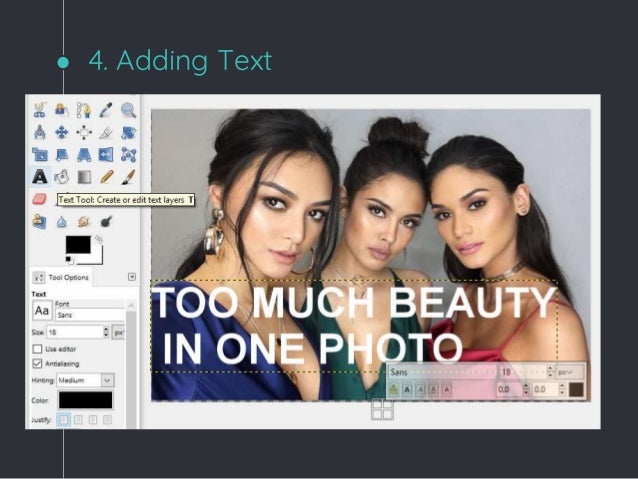
At first the layer will be opaque, but the opacity can be adjusted by sliding the opacity bar until you are satisfied with how it looks. To colour a layer, add a new layer, select the ‘bucket fill’ tool, choose a colour and click on the workspace to fill the new layer with colour.

The default settings for size and transparency will typically be appropriate. In the dialogue that appears, you can name the layer and make other adjustments. Layers can be added by right-clicking under the list of current layers and selecting ‘new layer’ or by selecting Layers > New Layer. If the ‘Layers’ menu is not visible, show it by clicking Windows > Recently Closed Docks > Layers, Channels, Paths…. By default, any text you add will appear as its own layer. Keeping each addition or change as a separate layer allows you to edit that layer without affecting the layers above or beneath it. Layers are very helpful for organizing your file, and any edits or additions you make. You can turn rulers off by clicking View > Hide Rulers, or using the keyboard shortcut Shift+Ctrl+R. Notice that the ruler across the top and side of the page will adjust to match the new dimensions (in pixels) of your image. Once you have selected the area you want cropped, press ‘enter’ on your keyboard to commit the changes.

To crop an image, select the ‘Crop’ tool in the toolbox (by clicking on the blade icon, or pressing Shift+C) and click and drag over your image to select the area of your photo you want to keep. If the toolbox is not visible, open it by selecting Tools > Toolbox from the top menu or pressing Ctrl+B. Alternatively, the ‘View’ menu has further zoom options such as ‘fit image in window’. Use the number keys 1 through 5 to zoom and adjust the view. Open GIMP, select File > Open and select the image to modify.

They can manipulate their image by adding pencil marks, text, coloured layers and more. In GIMP students can modify their own image or one they find online.


 0 kommentar(er)
0 kommentar(er)
